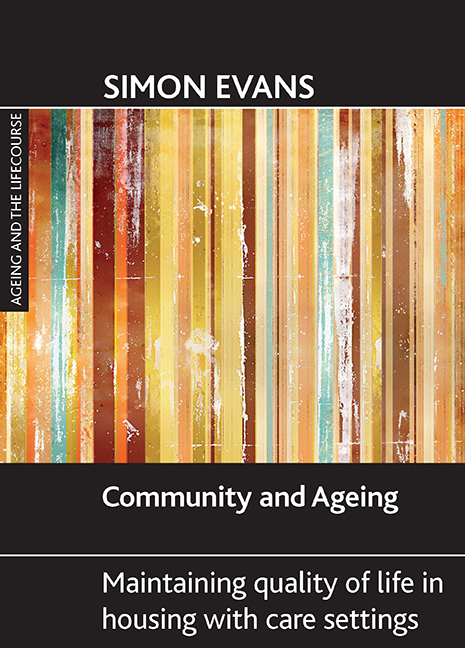Book contents
- Frontmatter
- Contents
- List of tables, boxes and photos
- Acknowledgements
- Foreword
- one Introduction
- two What is community?
- three Community and ageing
- four Housing with care communities in the UK
- five An international perspective on retirement villages
- six Promoting a sense of community in housing with care settings
- seven Diversity, community and social interaction
- eight Changing communities and older people
- nine Conclusion
- Appendix
- References
- Index
six - Promoting a sense of community in housing with care settings
Published online by Cambridge University Press: 05 July 2022
- Frontmatter
- Contents
- List of tables, boxes and photos
- Acknowledgements
- Foreword
- one Introduction
- two What is community?
- three Community and ageing
- four Housing with care communities in the UK
- five An international perspective on retirement villages
- six Promoting a sense of community in housing with care settings
- seven Diversity, community and social interaction
- eight Changing communities and older people
- nine Conclusion
- Appendix
- References
- Index
Summary
Introduction
Some forms of housing with care, particularly extra care housing and retirement villages, are marketed as communities for older people who have similar interests and lifestyles. This kind of marketing aims to appeal to older people's aspirations for community living and the fact that many feel alienated from a youth-focused society that sees ageing as a burden and places little value on the contribution that older people can make to society. There is no doubt that such settings are becoming increasingly popular and the evidence suggests that a sense of community is one of the main factors in choosing retirement housing. Given this, it is important to consider how the development of a sense of community can be promoted in housing with care schemes. This chapter explores the experiences of residents in terms of opportunities for social interaction and identifies a range of factors that can affect the development of a sense of community belonging.
How extra care housing and retirement villages market themselves as communities
Housing with care schemes are increasingly being marketed as communities. This is particularly evident from the descriptions found on many retirement village websites. For example, at Roseland Parc in Cornwall, ‘The village community atmosphere will allow you to forge new friendships with like-minded people who share your interests, your joys and your challenges in life’. Similarly, Richmond village in Coventry offers ‘peace, security and above all a real sense of community and gives residents genuine peace of mind’. What is striking about much of this marketing material is that the emphasis is on similarity rather than diversity. The use of the term ‘village’ is also interesting, given that many of these developments do not appear to fit with common usage of the word. For example, examination of a guide to 76 schemes that are described by their developers or managers as retirement villages (EAC, 2008b) reveals that many are in fact single buildings containing as few as 29 individual flats. As shown in Chapters Four and Five, there are also many larger schemes that appear on the surface to be much more village-like, comprising numerous buildings and a range of facilities.
- Type
- Chapter
- Information
- Community and AgeingMaintaining Quality of Life in Housing with Care Settings, pp. 71 - 92Publisher: Bristol University PressPrint publication year: 2009



